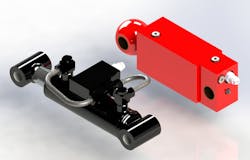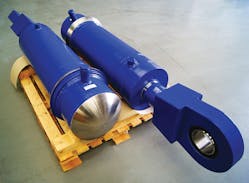Download this article as a .PDF
When you need a hydraulic cylinder for your equipment design, one major consideration is whether to purchase a catalog cylinder or a custom-made one. A catalog cylinder will always be close to matching your requirements, but with some compromises. For example, the bore may be slightly larger than what you need, and your choice of rod material and diameter are limited. The alternative: A custom-made cylinder allows you to purchase an item that fits your needs entirely, and is built to your specification. This designed cylinder will fit your machine without compromise and match your specifications exactly, thus eliminating under- or over-engineering.
Compared to an off-the-shelf cylinder with external valves and protruding pipework (left), a custom-built version with integrated valves provides a more compact, durable, and simpler assembly for a pipe-grab function within a confined space.
Can Off-the-Shelf be a Good Thing?
There may be some circumstances when a standard cylinder will suffice—for example, on mass-produced equipment with no special requirements. When designing a machine from scratch, you may choose to fit the machinery around a standard hydraulic cylinder. Bear in mind, though, that this will have its own implications. In most cases, fitting a standard cylinder into a design will uncover areas in which it is not optimum for your fabrication, whether that be seals, shape, size, mounting, port size, flow, or design criteria.
Custom designs can cover any imaginable scenario. Piston rods and other components are designed to the exact length and diameter required and made of materials that best suit the application. Valves and valve manifolds can be incorporated into the cylinder body. Custom-built cylinders can be made for specific operating conditions, such as high ambient pressure in deep-sea environments, high ambient temperatures in close proximity to furnaces, and other heat sources or extremely low temperatures (as in sub-arctic conditions). They can also be durable enough to actuate after remaining in the same extended or retraced position for decades or for continuous rapid, repetitive movements and variable strokes.
Custom-made hydraulic cylinders for a subsea mooring mechanism use a proprietary rod coating called Corex to resist corrosion, wear, and impact for underwater operation for decades.
Although many others exist, characteristics commonly required of custom cylinders include:
- special mounting styles
- unusual port or pin locations
- extremely long stroke, large bore, or unusual stroke-to-bore ratio
- restricted space
- exotic or unusual materials, coatings, or finishes
- integrated functions, such as manifolds, valves, or electronics
These cylinders are built for track tensioning machinery and use their cap end as a bearing surface to conserve space and reduce componentry.
Other Considerations
Few standard cylinders are produced with third-party approval, which requires documentation that the cylinder meets specific application requirements. Manufacturers of custom hydraulic cylinders should be able to provide test results witnessed by third-party inspection agencies and furnish certificates of conformity to whatever testing is required. This is one reason why OEMs that are able to manufacture their own cylinders don’t. Instead, they choose to have a custom cylinder manufacturer provide the cylinders complete with third-party documentation.
Over -(or under-) engineered cylinders. If you need a low-pressure cylinder but are purchasing a high-pressure cylinder because it’s close to what you need, you are using a cylinder that has been over engineered when a low-pressure, less expensive alternative could have been manufactured. The alternative; buying a pneumatic or other low-pressure cylinder and using it near the top of its working pressure rating will impact the longevity of the cylinder and potentially breach safety standards.
Cost of maintenance. If an off-the-shelf hydraulic cylinder is placed within a machine it is not specifically designed for, maintenance can be complicated, thereby driving up costs from service time machine downtime. For example, because port options are limited in standard cylinders, port locations may be difficult to access—making installation, service, and removal a time-consuming task.
If you build custom-made machines, choosing a catalogue cylinder generally means you compromise the design of your product to fit around the cylinder. However, the safest, most durable and efficient choice is to specify a custom hydraulic cylinder that has been optimized to compliment your product.
For more information contact Apex Hydraulics at its website or via e-mail.





